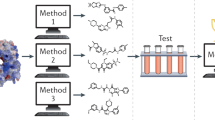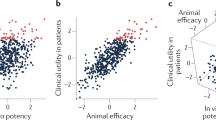Abstract
Pharmaceutical research and development is facing substantial challenges that have prompted the industry to shift funding from early- to late-stage projects. Among the effects is a major change in the attitude of many companies to their internal bioinformatics resources: the focus has moved from the vigorous pursuit of intellectual property towards exploration of pre-competitive cross-industry collaborations and engagement with the public domain. High-quality, open and accessible data are the foundation of pre-competitive research, and strong public–private partnerships have considerable potential to enhance public data resources, which would benefit everyone engaged in drug discovery. In this article, we discuss the background to these changes and propose new areas of collaboration in computational biology and chemistry between the public domain and the pharmaceutical industry.
This is a preview of subscription content, access via your institution
Access options
Subscribe to this journal
Receive 12 print issues and online access
$209.00 per year
only $17.42 per issue
Buy this article
- Purchase on Springer Link
- Instant access to full article PDF
Prices may be subject to local taxes which are calculated during checkout

Similar content being viewed by others
References
Garnier, J. P. Rebuilding the R&D engine in big pharma. Harv. Bus. Rev. 86, 68–70, 72–76, 128 (2008).
Kola, I. The state of innovation in drug development. Clin. Pharmacol. Ther. 83, 227–230 (2008).
Ledford, H. When there's no room to grow. Nature 454, 144–145 (2008).
Woodcock, J. & Woosley, R. The FDA critical path initiative and its influence on new drug development. Annu. Rev. Med. 59, 1–12 (2008).
Schieppati, A., Henter, J. I., Daina, E. & Aperia, A. Why rare diseases are an important medical and social issue. Lancet 371, 2039–2041 (2008).
Croft, S. L. Public–private partnership: from there to here. Trans. R. Soc. Trop. Med. Hyg. 99, S9–S14 (2005).
Butler, D. Drug patent plan gets mixed reviews. Nature 457, 1064 (2009).
Tralau-Stewart, C. J., Wyatt, C. A., Kleyn, D. E. & Ayad, A. Drug discovery: new models for industry–academic partnerships. Drug Discov.Today 14, 95–101 (2009).
Black, N. The Cooksey review of UK health research funding. BMJ 333, 1231–1232 (2006).
Wheeler, D. L. et al. Database resources of the National Center for Biotechnology Information. Nucleic Acids Res. 35, D5–D12 (2007).
Wishart, D. S. et al. DrugBank: a knowledgebase for drugs, drug actions and drug targets. Nucleic Acids Res. 36, D901–D906 (2008).
Degtyarenko, K. et al. ChEBI: a database and ontology for chemical entities of biological interest. Nucleic Acids Res. 36, D344–D350 (2008).
Seiler, K. P. et al. ChemBank: a small-molecule screening and cheminformatics resource database. Nucleic Acids Res. 36, D351-D359 (2008).
Holden, A. L. The SNP consortium: summary of a private consortium effort to develop an applied map of the human genome. Biotechniques Suppl., 22–24, 26 (2002).
Rhodes, J., Boyer, S., Kreulen, J., Chen, Y. & Ordonez, P. Mining patents using molecular similarity search. Pac. Symp. Biocomput. 12, 304–315 (2007).
Lengauer, T., Lemmen, C., Rarey, M. & Zimmermann, M. Novel technologies for virtual screening. Drug Discov. Today 9, 27–34 (2004).
Manly, C. J., Louise-May, S. & Hammer, J. D. The impact of informatics and computational chemistry on synthesis and screening. Drug Discov. Today 6, 1101–1110 (2001).
Loging, W., Harland, L. & Williams-Jones, B. High-throughput electronic biology: mining information for drug discovery. Nature Rev. Drug Discov. 6, 220–230 (2007).
Hwang, W. C., Zhang, A. & Ramanathan, M. Identification of information flow-modulating drug targets: a novel bridging paradigm for drug discovery. Clin. Pharmacol. Ther. 84, 563–572 (2008).
Schrattenholz, A. & Soskic, V. What does systems biology mean for drug development? Curr. Med. Chem. 15, 1520–1528 (2008).
Murphy, S. N. et al. A web portal that enables collaborative use of advanced medical image processing and informatics tools through the Biomedical Informatics Research Network (BIRN). AMIA. Annu. Symp. Proc. 2006, 579–583 (2006).
Houlton, S. Wellcome boost for open-access chemistry. Nature Rev. Drug Discov. 7, 789–790 (2008).
Hopkins, A. L. & Groom, C. R. The druggable genome. Nature Rev. Drug Discov. 1, 727–730 (2002).
Bradley, D. Dealing with a data dilemma. Nature Rev. Drug Discov. 7, 632–633 (2008).
Mattes, W. B. Public consortium efforts in toxicogenomics. Methods Mol. Biol. 460, 221–238 (2008).
Nelson, M. R. et al. The Population Reference Sample, POPRES: a resource for population, disease, and pharmacological genetics research. Am. J. Hum. Genet. 83, 347–358 (2008).
Birney, E. et al. Identification and analysis of functional elements in 1% of the human genome by the ENCODE pilot project. Nature 447, 799–816 (2007).
Collins, F. S., Rossant, J. & Wurst, W. A mouse for all reasons. Cell 128, 9–13 (2007).
Wellcome Trust Case Control Consortium. Genome-wide association study of 14,000 cases of seven common diseases and 3,000 shared controls. Nature 447, 661–678 (2007).
Hayden, E. C. International genome project launched. Nature 451, 378–379 (2008).
Kamel, N., Compton, C., Middelveld, R., Higenbottam, T. & Dahlen, S. E. The Innovative Medicines Initiative (IMI): a new opportunity for scientific collaboration between academia and industry at the European level. Eur. Respir. J. 31, 924–926 (2008).
Goodsaid, F., Frueh, F. & Mattes, W. B. The Predictive Safety Testing Consortium: a synthesis of the goals, challenges and accomplishments of the Critical Path. Drug Discov. Today Technol. 4, 47–50 (2008).
Wren, J. D. URL decay in MEDLINE — a 4-year follow-up study. Bioinformatics 24, 1381–1385 (2008).
Thireou, T., Spyrou, G. & Atlamazoglou, V. A survey of the availability of primary bioinformatics web resources. Genomics Proteomics Bioinformatics 5, 70–76 (2007).
Neumann, E. A life science semantic web: are we there yet? Sci. STKE 2005, e22 (2005).
Wilkinson, M. D. et al. Interoperability with Moby 1.0 — it's better than sharing your toothbrush! Brief. Bioinform. 9, 220–231 (2008).
Galperin, M. Y. & Cochrane, G. R. Nucleic Acids Research annual Database Issue and the NAR online Molecular Biology Database Collection in 2009. Nucleic Acids Res. 37, D1–D4 (2009).
Cornet, R. & de Keizer, N. Forty years of SNOMED: a literature review. BMC Med. Inform. Decis. Mak. 8, S2 (2008).
Liu, T., Lin, Y., Wen, X., Jorissen, R. N. & Gilson, M. K. BindingDB: a web-accessible database of experimentally determined protein-ligand binding affinities. Nucleic Acids Res. 35, D198–D201 (2007).
Mons, B. et al. Calling on a million minds for community annotation in WikiProteins. Genome Biol. 9, R89 (2008).
Carayannis, E. G. & Alexander, J. Strategy, structure, and performance issues of precompetitive R&D consortia: insights and lessons learned from SEMATECH. IEEE Trans. Eng. Manage. 51, 226–232 (2004).
Emilsson, V. et al. Genetics of gene expression and its effect on disease. Nature 452, 423–428 (2008).
Bentley, D. R. Whole-genome re-sequencing. Curr. Opin. Genet. Dev. 16, 545–552 (2006).
Acknowledgements
We thank members of the computational biology and computational chemistry and informatics groups within our companies. We also acknowledge partners at the EBI Industry forum for discussions that have contributed to our review of this area. We are grateful to Arricka Brouwer and the reviewers for suggestions as to how to improve the manuscript.
Author information
Authors and Affiliations
Corresponding authors
Ethics declarations
Competing interests
M.R.B., S.M.F. and M.D.H. are employees of GlaxoSmithKline. L.H., C.B. and B.W.J. are employees of Pfizer. S.T. and I.D. are employees of AstraZeneca.
Related links
Rights and permissions
About this article
Cite this article
Barnes, M., Harland, L., Foord, S. et al. Lowering industry firewalls: pre-competitive informatics initiatives in drug discovery. Nat Rev Drug Discov 8, 701–708 (2009). https://doi.org/10.1038/nrd2944
Published:
Issue Date:
DOI: https://doi.org/10.1038/nrd2944
This article is cited by
-
The RA-MAP Consortium: a working model for academia–industry collaboration
Nature Reviews Rheumatology (2018)
-
Implementation of a secure genome sequence search platform on public cloud-leveraging open source solutions
Journal of Cloud Computing: Advances, Systems and Applications (2012)
-
The Innovative Medicines Initiative: A European Response to the Innovation Challenge
Clinical Pharmacology & Therapeutics (2012)
-
Toward interoperable bioscience data
Nature Genetics (2012)
-
Common characteristics of open source software development and applicability for drug discovery: a systematic review
Health Research Policy and Systems (2011)



